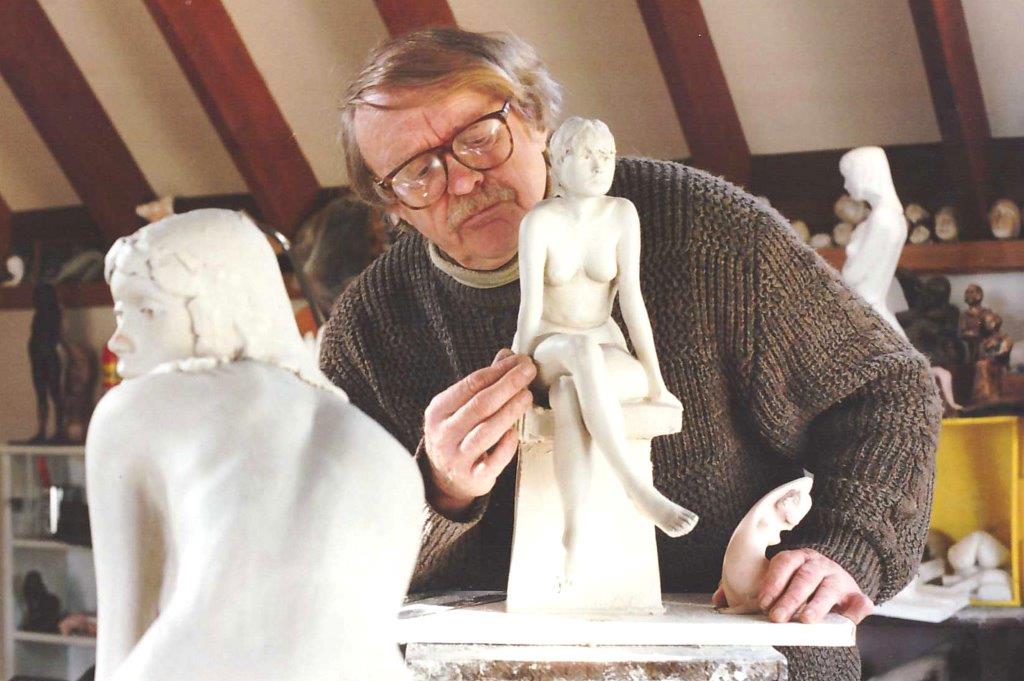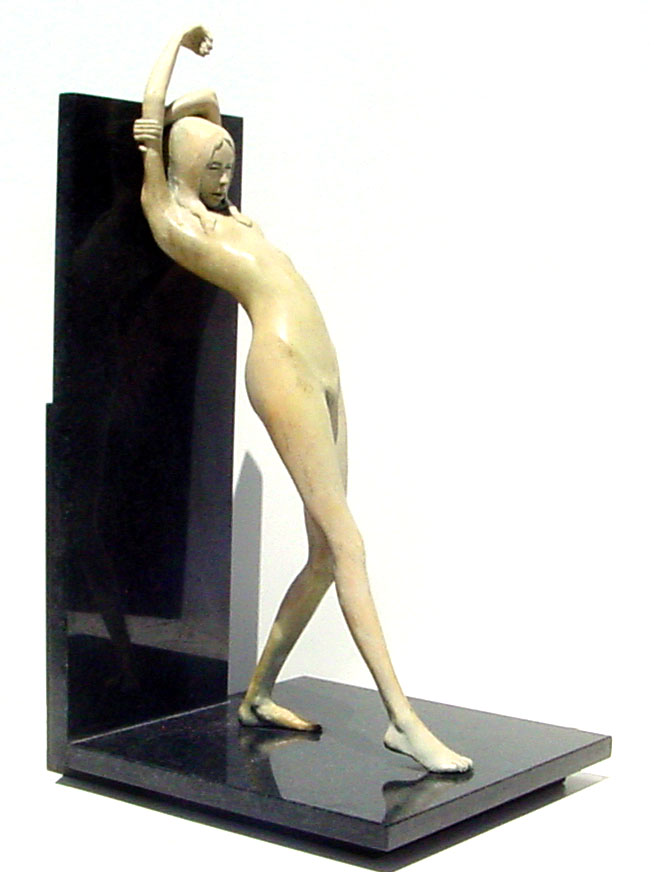|
PETER SMITH Biography
(1936-2005)

Peter Smith was
born
in Gloucester (England) in 1936.
Dr Peter Smith
was an
accomplished sculptor and passionate about art, sculpture,
painting and photography, film and music, food and wine.
A
certified medical doctor at Bristol University,
he graduated
medicine in 1962.
Peter Smith arrived to Australia in 1964, he continued
working as a doctor at the same time he embraced making
sculpture. Peter Smith developed enthusiasm for making
bronze sculpture to portray a woman in her sensual aspects.
Peter Smith worked mostly in bronze however he also used
clay and concrete.
Peter Smith was personally involved in finishing
his bronzes with a chosen patina. He
had widespread understanding and practice in making the
moulds for his own sculptures.
His
talent is accompanied by vast knowledge of materials and
experience in sculpture, and
wide-ranging expertise in casting bronzes.
Peter Smith accepted a president position of Boort Fiesta
from its Conception, an annual festival devoted to the Arts.
He participated in many art exhibitions.
Peter Smith work is
represented in many private collection
throughout
Australia, New Zeland and Europe.
As an artist,
Peter Smith was
fun-loving
and a
good-humoured, lovable man, who loved life.
Peter Smith
was ‘larger
than life’ his work continues give enjoyment to generations.
Peter Smith
was
the president of Boort Fiesta, an annual festival devoted to the Arts.
Peter Smith work is represented in collection
throughout
Australia, UK, New Zeland and Europe.
MAJOR EXHIBITIONS
 1984
Bendigo Fine Arts Gallery, VIC
1987
Manyung Gallery, Mount Eliza, VIC
1988 Shearers Arms Gallery, Geelong, VIC 1984
Bendigo Fine Arts Gallery, VIC
1987
Manyung Gallery, Mount Eliza, VIC
1988 Shearers Arms Gallery, Geelong, VIC
1989 Holdsworth Galleries, Sydney, NSW
1891 Terra Australian Gallery, Melbourne,
VIC
1994 Forest Gallery, NSW
1993 Holdsworth Galleries, Sydney, NSW
1995 Noosa Fine Arts Gallery, QLD
1995
Redhill Fine Arts Gallery, QLD
1996
Galeria Aniela Fine Art Gallery, NSW
1997
Redhill Fine Arts Gallery, QLD
1998 Forest Gallery, NSW
1999
Galeria Aniela Fine Art Gallery, NSW
Fairy
Lady
(From
Wikipedia, the free encyclopedia)
Pixies,
Sprite Country: Western European Habitat:
Woodland and Gardens.
A
Fairy (also faery, faerie, fay, fae;
euphemistically wee folk, good folk,
people of peace, fair folk) is a type of
mythical being or
legendary creature, a form of
spirit, often described as
metaphysical,
supernatural or
preternatural. Fairies resemble various
beings of other mythologies, though even
folklore that uses the term fairy offers
many definitions. Sometimes the term describes any
magical creature, including
goblins or
gnomes: at other times, the term only
describes a specific type of more
ethereal creature.
Fairies appeared in
medieval romances as one of the beings
that a
knight errant might encounter. Fairies in
literature took on new life with
Romanticism. Writers such as
Sir Walter Scott and
James Hogg were inspired by folklore
which featured fairies, such as the
Border ballads.
Fairies are generally described as human in appearance and having magical
powers.
Their origins are less clear in the folklore, being variously dead, or
some form of
demon, or a species completely
independent of humans or angels. Folklorists have suggested that their actual
origin lies in a conquered race living in hiding, or in religious beliefs that
lost currency with the advent of Christianity. These explanations are not
necessarily incompatible, and they may be traceable to multiple sources.
Much
of the folklore about fairies revolves around protection from their malice.
Although in modern culture they are often depicted as young, sometimes winged,
humanoids of small stature, they originally were depicted quite differently:
tall, radiant, angelic beings or short, wizened
trolls being two of the commonly
mentioned forms.
One common theme found among the
Celtic nations describes a race of
diminutive people who had been driven into hiding by invading humans. When
considered as beings that a person might actually encounter, fairies were noted
for their mischief and malice. Visit
http://en.wikipedia.org/wiki/Fairy
Mermaid
From
Wikipedia, the free encyclopedia -
Mermaid (disambiguation).
Similar creatures
Siren,
Merman,
Ondine.
A
mermaid is a legendary aquatic creature with the upper body of a female human
and the tail of a
fish. Mermaids appear in the
folklore of many cultures worldwide,
including the Near East, Europe, Africa and Asia.
The first stories appeared in
ancient
Assyria, in which the goddess
Atargatis transforms herself into a
mermaid out of shame for accidentally killing her human lover. Mermaids are
sometimes depicted as perilous creatures associated with floods, storms,
shipwrecks, and drowning.
In other folk traditions (or sometimes within the same
tradition) they can be benevolent, bestowing boons or falling in love with
humans.
Mermaids are associated with the
Sirens of Greek mythology and with the
Sirenia, a biological
order which comprises
dugongs and
manatees. Historical sightings by sailors
may have been the result of misunderstood encounters with these aquatic mammals.
Christopher Columbus reported seeing
mermaids while exploring the Caribbean, and sightings have been reported in the
20th and 21st centuries in Canada, Israel, and Zimbabwe. The US
National Ocean Service stated in 2012
that no evidence of mermaids has ever been found.
Mermaids have been a popular subject of art and literature in recent centuries.
Danish author
Hans Christian Andersen wrote his popular
fairy tale "The
Little Mermaid" in 1836. They have subsequently been depicted in
opera, paintings, books, films, and comics.
http://en.wikipedia.org/wiki/Mermaid
|